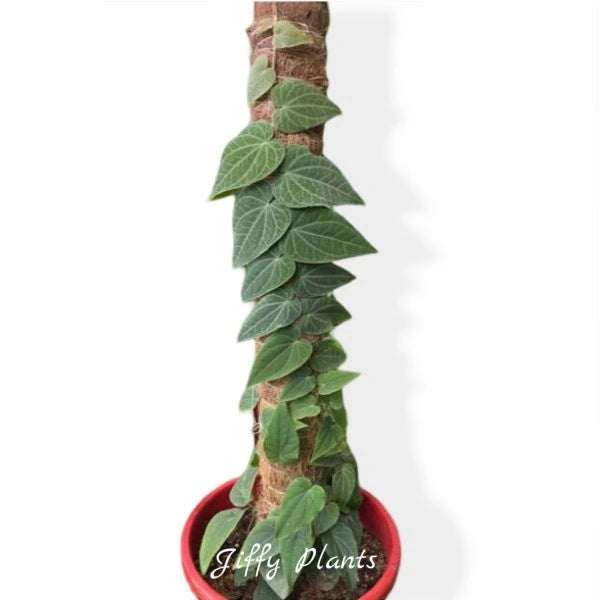
Piper Ribesioides (sp. South Sumatra)
Selling size: Single plant | 2.5" Pot Included | Free Shipping
Piper Ribesioides, especially the South Sumatra variety, is a fascinating tropical plant known for its beautiful foliage and climbing habit. While specific care information for the "South Sumatra" regional variant can be limited, general Piper ribesioides care guidelines apply, along with some nuanced considerations for its shingling nature.
Here's a comprehensive guide to caring for your Piper Ribesioides (sp. South Sumatra):
1. Light:
Bright, Indirect Light: This is crucial. Piper ribesioides thrives in bright, diffused light, mimicking its natural understory habitat in tropical forests.
Avoid Direct Sun: Direct sunlight can scorch its delicate leaves, especially the silver venation.
Terrarium/Greenhouse: If grown indoors, a terrarium or greenhouse setting is ideal as it allows for precise control of light and other environmental factors. If not in a terrarium, place it near a window with a curtain or shade.
Signs of Incorrect Light:
Too low light: Leggy growth, loss of variegation, drab coloration, and leaf drop.
Too much direct sun: Burned or discolored leaves.
2. Humidity:
High Humidity is Essential: Piper ribesioides is a tropical plant and demands high humidity, preferably between 70% to 90%. Anything below 70% is possible but might be experimental and require acclimation.
How to Increase Humidity:
Terrarium/Enclosed Environment: The best way to maintain high humidity.
Humidifier: Use a room humidifier near the plant.
Pebble Tray: Place the pot on a tray filled with pebbles and water (ensure the pot isn't sitting directly in the water).
Misting: While misting can provide a temporary boost, it's not a substitute for consistent high humidity.
3. Watering:
Keep Soil Consistently Moist, Not Soggy: Piper ribesioides does not tolerate drying out completely and is sensitive to lack of water, which can lead to rapid deterioration.
Check Soil Moisture: Water when the top half of the soil feels slightly dry to the touch. You can use your finger or a moisture meter.
Avoid Overwatering: Soggy soil can lead to root rot. Signs of overwatering include yellowing and wilting leaves, or a rotten odor.
Good Drainage is Key: Ensure the pot has drainage holes to prevent waterlogging.
4. Temperature:
Warm Environment: As a tropical plant, it prefers warm temperatures.
Ideal Range: Aim for temperatures between 18°C to 30°C (64°F to 86°F). It should get at least 18°C, preferably constantly above 20°C.
Avoid Cold Drafts: Protect it from sudden temperature drops or cold drafts.
5. Soil:
Loose, Well-Draining Potting Mix: A rich potting soil with excellent drainage is crucial.
Recommended Mixes:
Promix HP potting media.
Standard terrarium substrate.
A loose mix of coconut fiber and sphagnum moss.
A mixture of sand, soil, coir dust, and cow dung in equal proportions (for propagation).
pH: A pH range of 6 to 7 ensures optimal nutrient uptake.
6. Fertilization:
Moderate Feeder: Piper plants are not heavy feeders. "Less is more" applies here.
During Growing Season: Fertilize lightly during the active growing season (spring and summer).
Type of Fertilizer: Use a balanced liquid fertilizer at half strength every 2 weeks during active growth, or a gentle complete fertilizer (like orchid fertilizer).
Self-Sufficient: They can also thrive well in good planting substrate without excessive fertilization.
7. Climbing Support:
Climbing Habit: Piper ribesioides is a climber and will benefit from a support structure.
Suitable Supports: Provide a flat, reasonably rough surface for it to climb on, such as a wooden frame, moss pole, or even a piece of cork bark. Its shingling nature means its leaves will lie appressed to the surface as it climbs.
8. Propagation:
Stem Cuttings: This is a common and effective method.
Rooting Medium: Moist sphagnum moss is useful for rooting cuttings.
Cuttings: Cuttings with two nodes are often optimum for propagation.
Hormones: Indole-3-butyric acid (IBA) at 1,000 mg/L can improve sprouting and growth.
Rooting: Cuttings will typically start producing roots after 2-3 weeks.
Acclimation: If rooting in a high-humidity environment like a terrarium, gradually acclimate the new plants to average home humidity if they are to be moved out.
9. Pests and Diseases:
Monitor Regularly: Keep an eye out for common houseplant pests.
Common Pests: Piper plants can attract pests like spider mites or mealybugs.
Treatment: If you see any signs of pests, treat the plant immediately with insecticidal soap or neem oil solution.
Diseases: While information specifically for P. ribesioides diseases is limited, general Piper species can be susceptible to issues like root rot (from overwatering) and fungal problems in overly humid and poorly ventilated conditions. Good airflow is important.
Key takeaway for Piper Ribesioides (sp. South Sumatra): This species thrives in conditions that mimic its native tropical rainforest environment: high humidity, warm temperatures, bright indirect light, consistently moist but well-draining soil, and something to climb on.

